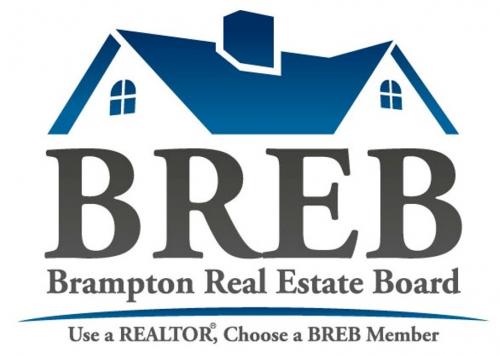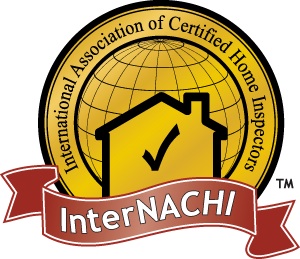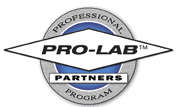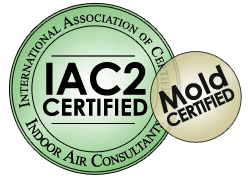Suggested Mold clean-up procedures
•“Small areas” of mold can be cleaned with a detergent solution.
•Wear a mask, safety goggles and rubber gloves.
•Seek professional help if there is a lot of mold or if mold comes back after cleaning.
Bleach is NOT recommended
The presence of organic (humic) materials, the pH (acidity/alkalinity) of the water, the surface material and contact time affect the effectiveness of bleach for disinfection. Since these factors are not generally controlled, bleach cannot be relied upon for disinfection. The most compelling reason for advising against bleach is that fumes are harmful but in addition, overuse of bleach will result in increased releases of chlorinated effluents which can be harmful to the environment.
“Small area” clean-up
You can clean up “small areas” of mold (fewer than three patches, each smaller than a square meter) yourself. The minimum protective wear needed are:
•safety glasses or goggles;
•a disposable dust mask (3M 8210 or equivalent); and
•household rubber gloves.
Infants and other family members with asthma, allergies or other health problems should not be in the work area or adjacent room during the cleaning.
Washable surfaces:
Scrub with an unscented detergent solution; then sponge with a clean, wet rag and dry quickly.
Using an unscented detergent will make it easier for you to detect residual moldy odours.
Moldy drywall:
Clean the surface with a damp rag using baking soda or a bit of detergent. Do not allow the drywall to get too wet.
Mold that comes back after cleaning is usually an indication that a source of moisture has not been removed. Seek professional help from a trained IAQ investigator.
"Moderate area" clean-up
•Clean “moderate areas” of mold, but wear proper protective equipment and follow precautions.
•Seek professional help if there is a lot of mold or if mold comes back after cleaning.
If you follow the proper procedures and use the proper protective equipment, you can clean up “moderate areas” of mold. “Moderate” means more than 3 patches of mold, each smaller than one square meter, or one or more isolated patches larger than one square meter but smaller than 3 square meters (size of a 4 x 8 foot sheet of plywood).
Safety precautions
•Wear a disposable dust mask (for example, 3M 8210 or equivalent), glasses or safety goggles and household rubber gloves.
•Isolate the area to be cleaned with plastic sheeting, taped to walls and ceiling.
•Infants and other family members suffering from asthma, allergies or other health problems should not be in the work area or adjacent room during the cleaning.
A small clean up should take minutes (not hours) to finish. When the clean up takes hours to a day to finish, it is suggested that you upgrade to a better filter, such as a half-face respirator with charcoal cartridges. An exhaust fan installed in a window in the room being cleaned would prevent contamination of other areas of the house as well as provide ventilation.
General cleaning
Vacuum surfaces with a vacuum cleaner which has a High Efficiency Particulate Air (HEPA) filter or is externally exhausted. Scrub or brush the moldy area with a mild unscented detergent solution. Rinse by sponging with a clean, wet rag. Repeat. Dry quickly. HEPA vacuum the surfaces that were cleaned as well as surrounding areas.
Cleaning wood surfaces
Vacuum loose mold from wood surfaces using a HEPA or externally exhausted vacuum. Try cleaning the surface of the wood with detergent and water. Rinse with a clean, damp rag and dry quickly. If the staining does not come off, sand and vacuum the surface of the wood with a vacuum/sander combination. It is important to vacuum at the same time to prevent mold spores from being dispersed into the air. Note that wood affected by rot may need to be replaced.
Cleaning concrete surfaces
Vacuum the concrete surfaces to be cleaned with a HEPA or externally exhausted vacuum cleaner. Clean up surfaces with detergent and water. If the surfaces are still visibly moldy, use TSP (trisodium phosphate). Dissolve one cup of TSP in two gallons of warm water. Stir for two minutes. Note: TSP must not be allowed to come in contact with skin or eyes. Saturate the moldy concrete surface with the TSP solution using a sponge or rag. Keep the surface wetted for at least 15 minutes. Rinse the concrete surface twice with clean water. Dry thoroughly, as quickly as possible.
Moldy drywall
The paper facings of gypsum wallboard (drywall) grow mold when they get wet or repeatedly wet and don’t dry quickly. Cleaning with water containing detergent not only add moisture to the paper but also can eventually damage the facing. If the mold is located only on top of the painted surface, remove it by general cleaning (see above). If the mold is underneath the paint, the moldy patch and other moldy material behind it are best cut out and the surrounding areas also cleaned. This should be done by a mold clean-up contractor. New materials may become moldy if the moisture entry has not been stopped. If this is the case, replacement of the materials should be deferred until the source of the moisture is corrected. The affected areas should be temporarily covered with plastic sheeting and sealed at the edges.
Any areas that show new patches of mold should be cleaned promptly.
Dealing with an ongoing problem
Repair to the building envelope is required if moisture is entering the home from the outside. At the same time, steps should be taken inside the home to reduce the occupants’ exposure to mold.
http://www.epa.gov/mold
|
Mold Basis
Molds are organisms that may be found indoors and outdoors. They are part of the natural environment and play an important role in the environment by breaking down and digesting organic material, such as dead leaves. Also called fungi or mildew, molds are neither plants nor animals; they are part of the kingdom Fungi.
Molds can multiply by producing microscopic spores (2 - 100 microns [µm] in diameter), similar to the seeds produced by plants. Many spores are so small they easily float through the air and can be carried for great distances by even the gentlest breezes. The number of mold spores suspended in indoor and outdoor air fluctuates from season to season, day to day, and even hour to hour.
Is Mold in my House?
Mold is Everywhere. Mold spores are ubiquitous; they are found both indoors and outdoors. Mold spores cannot be eliminated from indoor environments. Some mold spores will be found floating through the air and in settled dust; however, they will not grow if moisture is not present.
Should I Be Concerned?
Mold is not usually a problem indoors -- unless mold spores land on a wet or damp spot and begin growing. As molds grow they digest whatever they are growing on. Unchecked mold growth can damage buildings and furnishings; molds can rot wood, damage drywall, and eventually cause structural damage to buildings. Mold can cause cosmetic damage, such as stains, to furnishings. The potential human health effects of mold are also a concern. It is important, therefore, to prevent mold from growing indoors.The risk to a person's health is seriously elevated when levels of mold spores indoors is greater than outdoor levels. Air sampling during a mold inspection will compare indoor mold spore levels to the outdoor mold spore levels.
Why and Where Mold can Grows?
Mold can grow on virtually any organic material as long as moisture and oxygen are present. There are molds that grow on wood, paper, carpet, food, and insulation. Because mold eats or digests what it is growing on, it can damage a building and its furnishings. If left unchecked, mold eventually can cause structural damage to building materials.
Molds gradually destroy the things they grow on. You can prevent damage to buildings and building contents, save money, and avoid potential health problems by controlling moisture and eliminating mold growth.
Eliminating all mold and mold spores indoors is virtually impossible, but controlling indoor moisture will control the growth of indoor mold.
How can I tell if I have a Mold Problem?
Molds are part of the natural environment. Outdoors, molds play a part in nature by breaking down dead organic matter such as fallen leaves and dead trees, but indoors, mold growth should be avoided. Molds reproduce by means of tiny spores; the spores are invisible to the naked eye and float through outdoor and indoor air. Mold may begin growing indoors when mold spores land on surfaces that are wet. There are many types of mold, and none of them will grow without water or moisture.
It is impossible to get rid of all mold and mold spores indoors; some mold spores will be found floating through the air and in house dust. The mold spores will not grow if moisture is not present. Indoor mold growth can and should be prevented or controlled by controlling moisture indoors. If there is mold growth in your home, you must clean up the mold and fix the water problem. If you clean up the mold, but don't fix the water problem, most likely, the mold problem will come back.
What does mold smell like?
Moldy Smell!!Some compounds produced by molds have strong smells and are volatile and quickly released into the air. These compounds are known as microbial volatile organic compounds (mVOCs). Because mVOCs often have strong or unpleasant odors, they can be the source of the "moldy odor" or musty smell frequently associated with mold growth. A moldy odor suggests that mold is growing in the building and should be investigated.
The health effects of inhaling mVOCs are largely unknown, although exposure to mVOCs has been linked to symptoms such as headaches, nasal irritation, dizziness, fatigue, and nausea. More research is needed to determine whether there are any human health effects from non-occupational indoor exposures to mVOCs.
The Key to Mold Control is Moisture Control.
It is important to dry water damaged areas and items within 24-48 hours to prevent mold growth. If mold is a problem in your home, clean up the mold and get rid of the excess water or moisture. Fix leaky plumbing or other sources of water. Wash mold off hard surfaces with detergent and water, and dry completely. Absorbent materials (such as ceiling tiles & carpet) that become moldy may have to be replaced.
Can mold cause health problems?
Molds are usually not a problem indoors, unless mold spores land on a wet or damp spot and begin growing. Molds have the potential to cause health problems. Molds produce allergens (substances that can cause allergic reactions), irritants, and in some cases, potentially toxic substances (mycotoxins). Inhaling or touching mold or mold spores may cause allergic reactions in sensitive individuals. Allergic responses include hay fever-type symptoms, such as sneezing, runny nose, red eyes, and skin rash (dermatitis). Allergic reactions to mold are common. They can be immediate or delayed. Molds can also cause asthma attacks in people with asthma who are allergic to mold. In addition, mold exposure can irritate the eyes, skin, nose, throat, and lungs of both mold-allergic and non-allergic people. Symptoms other than the allergic and irritant types are not commonly reported as a result of inhaling mold. Research on mold and health effects is ongoing.
What Levels of Mold Spores can make Me Sick?
Levels that determine safe and unsafe amounts of mold indoors have not yet been established. Health Canada has no absolute levels for safe or unsafe mold levels inside a home or building. Because everyone’s immune system is different, what might be a harmless amount of mold exposure to one occupant can be devastating health-wise to another person.
How do I get rid of mold?
It is impossible to get rid of all mold and mold spores indoors; some mold spores will be found floating through the air and in house dust. The mold spores will not grow if moisture is not present. Indoor mold growth can and should be prevented or controlled by controlling moisture indoors. If there is mold growth in your home, you must clean up the mold and fix the water problem. If you clean up the mold, but don't fix the water problem, then, most likely, the mold problem will come back.
Should I have my House Air Tested for Mold?
The only to determine with certanty if mold is contaminating an Indoor Air Enviroment is by Sampling.Air sampling requires specialized equipment. An air sample typically captures mold spores in a period of minutes.
Since replicate samples must be taken due to variations in the airborne molds over time [even hours] and compare with outdoor samples [control].
According to Dr. John D. Shane, Vice President of Laboratory services of PRO-LAB millions of homes across America have hidden water leaks that are promoting mold growth that can expose homeowners to mold spores. Mold has a potential to cause health problems like allergies, irritation (to lungs, eyes, skin, throat, nose) and are potentially toxic. Inhaling and touching mold spores may cause allergic reactions in sensitive individuals and normally healthy individuals may become sensitive to mold after exposure.
The EPA [Environmental Protection Agency] states that, "It is important to take precautions to limit your exposure to mold and mold spores. Avoid breathing in mold or mold spores". The EPA also recommends that if you suspect you have a hidden mold problem you should consider hiring an experienced professional to avoid exposure to potentially massive doses of mold spores.
Mold damages what it grows on. The longer it grows the more damage it can cause. If there is a mold problem in your home, you should clean up the mold promptly. Mold can be hidden, growing on the water from a hidden leak, and can develop into a potentially large problem if not caught in time.
Testing your home on a regular basis is a prudent way to prevent small problems from growing into a costly and unhealthy situation, and always avoid exposing yourself and others to mold.
WHO IS MORE SUSCEPTIBLE TO MOLD?
Mold infestation puts certain individuals at a higher risk to the toxic effects including:
>Infants and young children
>The elderly
>Individuals with existing respiratory conditions, such as allergies, chemical sensitivities, or asthma.
>Persons with weakened immune systems (such as people with HIV infection, cancer chemotherapy patients, and so forth).
>Anyone with health problems they believe are due to mold should consult a medical professional.
Repeted exposure to high levels of mold spores can also have serious effects on a " healthy individual"
MOLD, MOISTURE AND YOUR HOME

The key to mold control is moisture control.
If mold is a problem in your home, you should clean up the mold promptly and fix the water problem.
It is important to dry water-damaged areas and items within 24-48 hours to prevent mold growth.
Ten Things You Should Know About Mold
I. Potential health effects and symptoms associated with mold exposures include allergic reactions, asthma, and other respiratory complaints.
II. There is no practical way to eliminate all mold and mold spores in the indoor environment; the way to control indoor mold growth is to control moisture.
III. If mold is a problem in your home or school, you must clean up the mold and eliminate sources of moisture.
IV. Fix the source of the water problem or leak to prevent mold growth.
V. Reduce indoor humidity (to 30-60% ) to decrease mold growth by: venting bathrooms, dryers, and other moisture-generating sources to the outside; using air conditioners and de-humidifiers; increasing ventilation; and using exhaust fans whenever cooking, dishwashing, and cleaning.
VI. Clean and dry any damp or wet building materials and furnishings within 24-48 hours to prevent mold growth.
VII. Clean mold off hard surfaces with water and detergent, and dry completely. Absorbent materials such as ceiling tiles, that are moldy, may need to be replaced.
VIII.Prevent condensation: Reduce the potential for condensation on cold surfaces (i.e., windows, piping, exterior walls, roof, or floors) by adding insulation.
IX. In areas where there is a perpetual moisture problem, do not install carpeting (i.e., by drinking fountains, by classroom sinks, or on concrete floors with leaks or frequent condensation).
X. Molds can be found almost anywhere; they can grow on virtually any substance, providing moisture is present. There are molds that can grow on wood, paper, carpet, and foods.
Moisture and Mold Prevention and Control Tips
When water leaks or spills occur indoors - ACT QUICKLY. If wet or damp materials or areas are dried 24-48 hours after a leak or spill happens, in most cases mold will not grow.
Clean and repair roof gutters regularly.
Make sure the ground slopes away from the building foundation, so that water does not enter or collect around the foundation.
Keep air conditioning drip pans clean and the drain lines unobstructed and flowing properly.
Keep indoor humidity low. If possible, keep indoor humidity below 60 percent (ideally between 30 and 50 percent) relative humidity. Relative humidity can be measured with a moisture or humidity meter, a small, inexpensive ($10-$50) instrument available at many hardware stores.
If you see condensation or moisture collecting on windows, walls or pipes ACT QUICKLY to dry the wet surface and reduce the moisture/water source. Condensation can be a sign of high humidity.
Actions that will help to reduce humidity
Vent appliances that produce moisture, such as clothes dryers, stoves, and kerosene heaters to the outside where possible. (Combustion appliances such as stoves and kerosene heaters produce water vapor and will increase the humidity unless vented to the outside.)
Use air conditioners and/or de-humidifiers when needed.
Run the bathroom fan or open the window when showering. Use exhaust fans or open windows whenever cooking, running the dishwasher or dishwashing, etc.
Actions that will help prevent condensation
Actions that will help prevent condensation
Reduce the humidity.
Increase ventilation or air movement by opening doors and/or windows, when practical. Use fans as needed.
Cover cold surfaces, such as cold water pipes, with insulation.
Increase air temperature.
MOLD INSPECTION
WHAT'S THE DIFFERENCE BETWEEN A MOLD INSPECTION AND A HOME INSPECTION?
A regular Home Inspection will indicate:
- Water damage
- Basment leaks
- Moisture stains
- Roof leaks
A regular Home Inspection will NOT indicate:
- Mold growth behind walls, ceilings and insolation
- Type of mold growing in the home
- Humidity levels from room to room to detect hidden moisture problems
- Moisture content of drywall, hardwood floors and window sills.
WHO SHOULD HAVE A MOLD INSPECTION ?
A mold Inspection should be done on a home when the home inspoector or the buyer suspects or detect the following:
>Previous roof or basement leaks
>Water stains, new or old on ceilings, floors or walls
>Showers,sinks,buthtubs, toliet leaks
>Cold storage area has visible mold
>Any room has visible mold
>Rooms have a musty smell
>Excessive staining on carpeting
>The property was used as a rental
Mold inspections should be perform regardless of the home's age, new or old, mold only need 24 to 48 hours to grow, not 10 years. If the home was a rental property, it is more likely that the tenants did not report water leaks.
|
mold spores 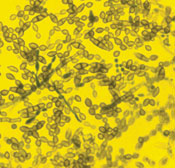 Molds gradually destroy the things they grow on. You can prevent damage to your home and furnishings, save money, and avoid potential health problems by controlling moisture and eliminating mold growth
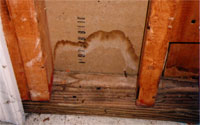
Water stain on a basement wall --
locate and fix the source of the water promptly.

Mold growing on the back side of wallpaper.
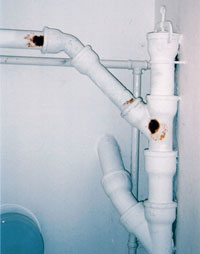
Rust is an indicator that condensation occurs on this drainpipe.
The pipe should be insulated to prevent condensation.

Condensation on the inside of a windowpane.
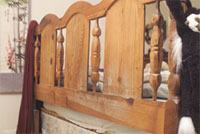
Mold growing on a wooden headboard in a room with high humidity.
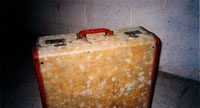
moldy suitcase
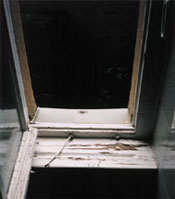
Leaky window - mold is beginning to rot the wooden frame and windowsill.
If you already have a mold problem - ACT QUICKLY.
Mold damages what it grows on.
The longer it grows, the more damage it can cause
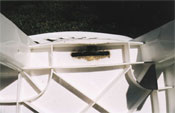
Mold growing on the underside of a plastic lawn chair
in an are where rainwater drips through and deposits organic material.
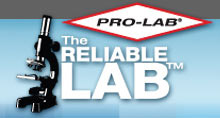
|




